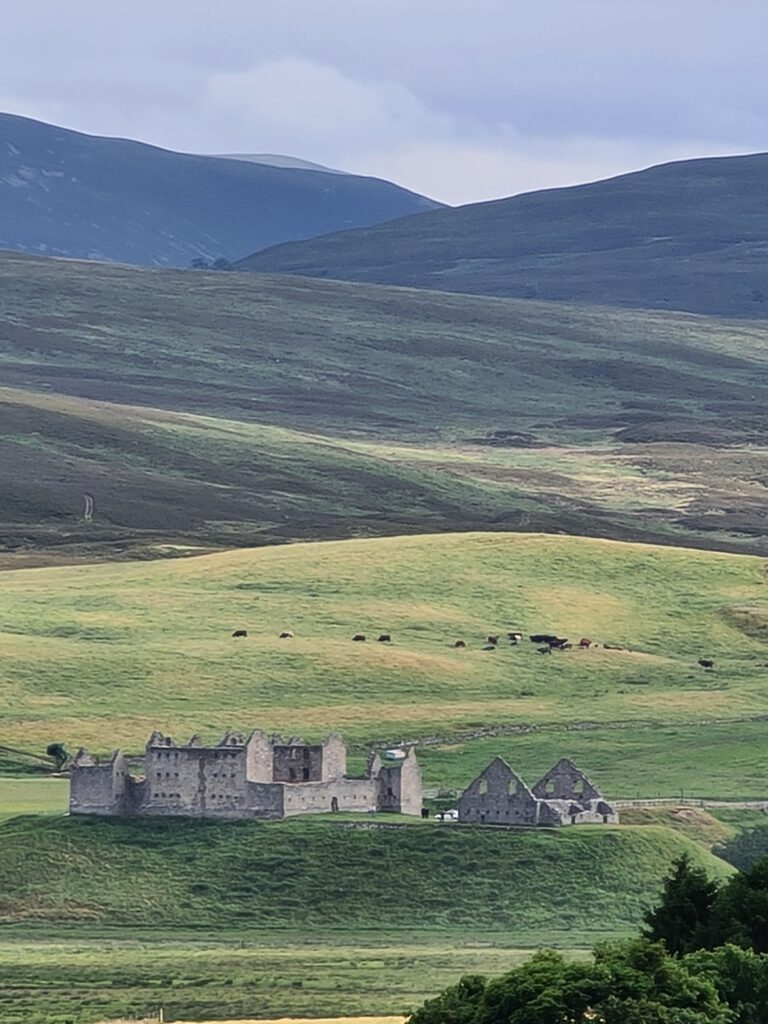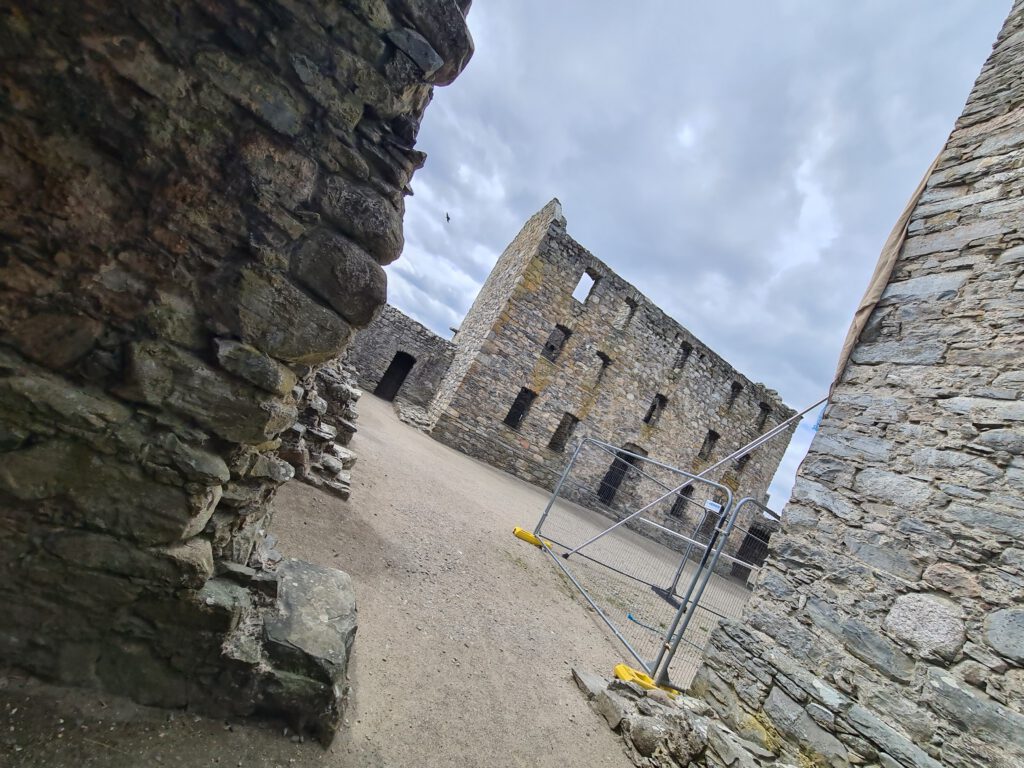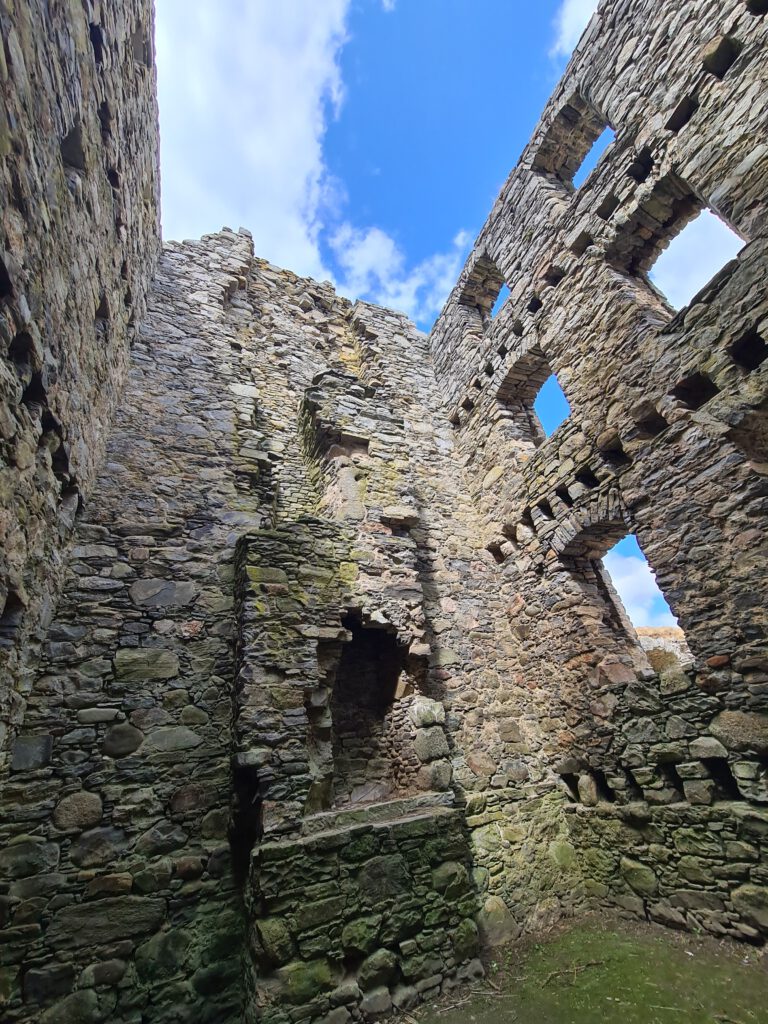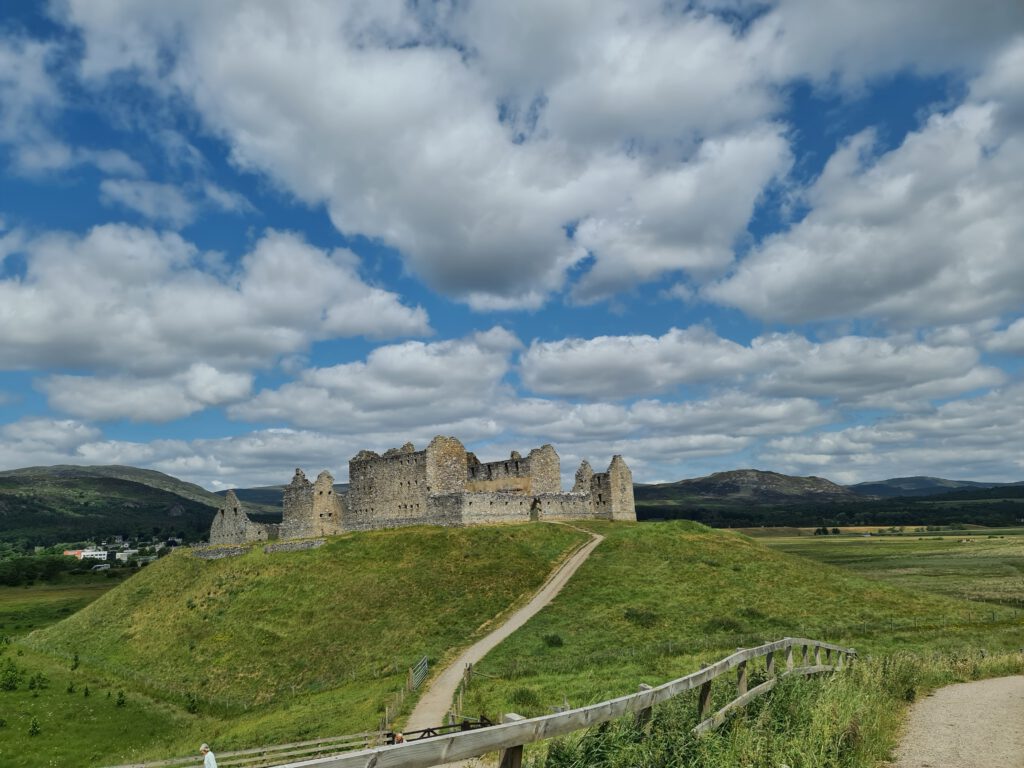Location: near Ruthven, Strathspey & Badenoch, Highlands of Scotland
kind of castle: barracks, former site of a castle structure
today: open to the public
public transport: buses to Kingussie, short walk from there
scheduled monument: yes
managed by: Historic Environment Scotland
entrance fee: £ 0
opening times: 24/7
directions: Ruthven Barracks – Google Maps

Commonly referred to as either Ruthven Barracks or Ruthven Castle the buildings we can still see today are not in any way related to a castle anymore. However, dating back to the 13th century there was a castle structure on the top of the prominent mound before the castle was built during the Jacobite Risings.
With its location in the historic county of Badenoch it is no wonder that the original castle structure is widely believed to have been built by the Comyns of Badenoch, later to produce the world-famous Wolf of Badenoch.

The first castle being built around 1229, it survived until 1451 before it was destroyed by the Earl of Ross at the time being John of Islay. What makes the building process even more likely to have been made on the order of the Comyns is that the Lords of Badenoch, who were also the chiefs of the Clan Comyn, is that it is known that the Earl of Buchan used the castle as a base for his “Wolf of Badenoch” activities.

After the first castle complex was demolished, the locals didn’t waste much time and finished building the second castle on the site only 8 years later in 1459. But during this time and especially after the fall of the Wolf of Badenoch, the castle was besieged a fair bit and reportedly was held by the Earls of Huntly during the 15th and 16th century. By that it passed from the Comyns to the Gordons, with the Earls of Huntly being the chiefs of Clan Gordon, the new Lords of Badenoch.

Getting not only involved in the Wars of the Three Kingdoms but also in the Jacobite rising of 1689, the later one was the downfall of the second build castle at the site, the 1st Viscount of Dundee at the time, John Graham and his Jacobites, severely damaged it during their attack.
During the time of the second castle there were not only the local lords visiting but also royalty. King James II reportedly visited after the second castle had been built and Mary Queen of Scots has stayed at the castle as well. However, this didn’t keep the castle ending up completely gone after the destruction trough Bonnie Dundee and previously through two fires.

The Scottish occupation of the mound didn’t stop in that time though, although the new barracks were built by the redcoats as a response to the Jacobite Rising of 1715. Finishing the work of Ruthven Barracks and three other ones in 1721 the barracks saw quite a little bit of action before being destroyed by the retreating Jacobites after the Battle of Culloden. Yet the timespan of the barracks history is short, lasting only about 25 years.

Built under an attempt to finally bring order into the unruly Highlands of Scotland the Barracks were designed to hold a garrison of English, up to 120 men and just little under 30 horses, impressive to be sure. The old castle mound, most likely naturally created by retreating glaciers many centuries earlier, offered the best possible advantageous position, overlooking great distances and making the locals feel small. The British Army knew for what they were building the complex of three two-storey buildings and towers in the corners and lucky for us today, there is still a very good picture of the structure left to be visited.

With its location at the meeting of three of General Ward’s Military Roads the complex also had a protective manner, overlooking great distances of the Spey Valley and one of the only crossing points, its role for sure was vital to prevent many an attack, the real action however, didn’t reach the Barracks until 1745 and the last Jacobite Rising. Only always commanded by a small number of soldiers, when the first attack fell in August 1745 the Sergeant Terrence Molloy had to defend the barracks against the approaching Jacobites, counting about 200 to 300, with only 12 of his own men, a hard task of which he proved to be worthy.

Loosing only one of his men killed the fought of the Jacobites, wounding and killing more than their own loss counted. The Scots wouldn’t be Scots fighting for their believe if they gave up that easily and so while still commanded by Molloy, the Barracks suffered a second attack by the Jacobites in February 1746. Led by John Gordon of Glenbuchat they had learned from previous mistakes and brought cannons to the party, the now Lieutenant Molloy had no other chance than to surrender.

And so, the barracks passed into Jacobite hands, never to return to the government’s troops, at least not in a fortified state. The Barracks had seen the last of the action and while it is often seen as most of the Jacobites dying at the The Battle of Culloden – A scottish World, little is told of the approximately 3,000 Jacobites escaping the massacre with their lives (at least for a short while) retreating and regrouping at Ruthven Barracks. Arriving there the day after the battle on 16th April 1746 they waited for word from the Bonnie Prince, ready to fight again and die fighting if need be.

But Charlie had come to the conclusion that the cause was lost for this moment in time. And when his word arrived on 20 April it was a sad word for all those who had fought for him, to some maybe even feeling like betrayal. “Let every man seek his own safety in the best way he can” was the key sentence deeming their position hopeless. Hope was gone and with the aftermath of Culloden it can be said for sure that most of those 3,000 surviving met the same fate as their dead comrades on the battlefield, soon after leaving Ruthven Barracks, heartbroken they were deemed outlaws to be shipped to the colonies or even killed.
Set on suppressing not only the Jacobites but the Highlands once and for all, the Government was relentless and to take at least something from them, the retreating Jacobites burned the barracks, leaving only an empty shell standing on the mound next to the River Spey, only the exterior walls surviving (floors obviously made of wood were the burning part of the barracks).

And while so little and yet so much survived till today you can still see the earthworks of the two earlier castles and the old well, which are the only remnants of the two castles that once stood high up, having more history than the barracks that are a leftover from dark times for the Scottish hearts, set on hope of a Stewart King returning to the throne.
Cruel are a lot of places but there is no point in dwelling in this cruelty, for there is more to be experienced even in the dark places of history and with this we come to maybe one of my favourite parts of history, the ghost stories connected to big parts of it. Essential for the nature of the Scots. The ghost story connected to Ruthven (while it was still a castle) involves an old tale with no one other but the devil in person as one of the main characters.

While belonging to the Wolf of Badenoch who reputedly had dabbled in witchcraft, in July 1394 a strange visitor arrived at the castle, challenging Alexander to a game of chess. Fully dressed in black the stranger got what he wanted, and the game was played. Nothing suspicious here, but when the morning came not a single soul in the castle was left alive. This is what happens when playing chess with the Devil, the perils of it can be death. On a stormy day or a dark evening, to this very day, you can find the shades of the Wolf of Badenoch and his followers playing chess with the devil, haunting the barracks. The ghosts having survived the destruction of the second castle and the Barracks, haunting the ruins of the later.

Knowing Scotland this is but one of many tales haunting the lands of the living souls. And yet it gets you thinking and maybe even break a sweat when wandering on your own through the old stone buildings, the sounds of the busy A9 far in the distance. Enjoy this peace and the opportunity to travel through time, not literally, but with your mind. History has been made at this place, as important as Culloden itself was, Ruthven Barracks is a place where the aftermath especially on a sentimental basis was set in stone, for hope and hearts were crushed here when receiving final word from Prince Charles Edward Stuart.

It is a truly nice place to visit and when clicking through my Route Reviews – A scottish World you will find a route including the Barracks, only a short distance outside Kingussie (if you got time, don’t take the car but wander along the road to the Barracks, it is not far and gives some lovely impressions of the area). When I visited the place there was some construction undertaken, don’t be put off by it, it is essential to keep many historic buildings accessible and Historic Environment Scotland is doing a great job with it, so feel free to donate to keep Scotland’s History accessible for generations to come.
*This is no advertisement, I just really appreciate the work they do.*


